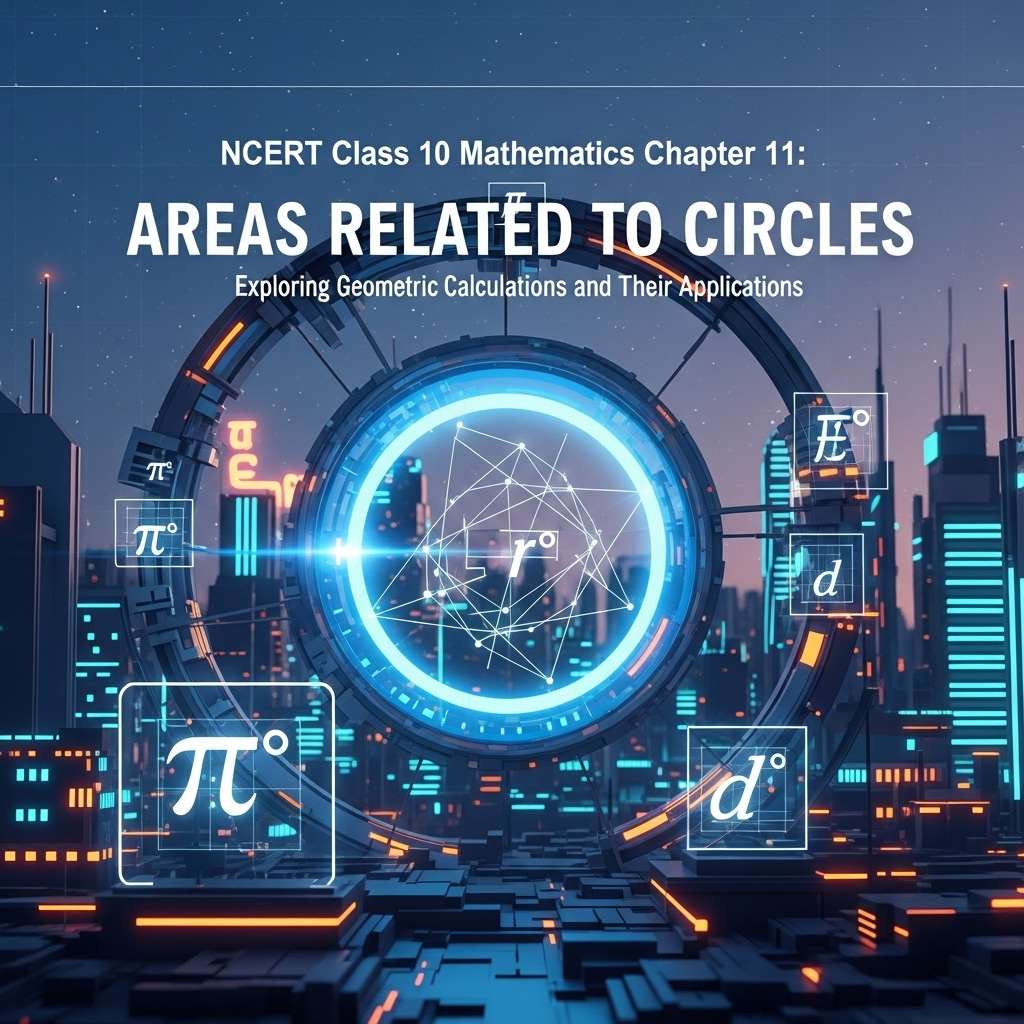Complete Solutions and Summary of Areas Related to Circles – NCERT Class 10, Mathematics, Chapter 11 – Summary, Questions, Answers, Extra Questions
Comprehensive summary and explanation of Chapter 11 'Areas Related to Circles', covering concepts of area and perimeter of circles, area of sectors and segments, arc length, perimeter of sector, derivations and formulas for calculating areas of segments, practical applications, and solved exercises from NCERT Class X Mathematics.
Updated: 1 month ago
Categories: NCERT, Class X, Mathematics, Summary, Extra Questions, Circles, Area Calculations, Sectors, Segments, Arc Length, Geometry, Chapter 11

Areas Related to Circles
Chapter 11: Mathematics - Ultimate Study Guide | NCERT Class 10 Notes, Questions, Examples & Quiz 2025
Full Chapter Summary & Detailed Notes - Areas Related to Circles Class 10 NCERT
Overview & Key Concepts
- Chapter Goal: Understand areas of sectors and segments in circles, their formulas, and applications. Exam Focus: Calculations of areas, lengths of arcs, word problems involving real-life scenarios like clocks, umbrellas, and fields. 2025 Updates: Emphasis on practical applications and derivations. Fun Fact: The concept of sectors dates back to ancient geometry for dividing circles in architecture. Core Idea: Sectors and segments help calculate partial areas of circles. Real-World: Clock hands sweeping areas, horse grazing in fields, umbrella ribs.
- Wider Scope: Builds on circle properties from previous chapters, useful in physics (rotational motion) and engineering (designing circular objects).
11.1 Areas of Sector and Segment of a Circle
- Sector Definition: Portion enclosed by two radii and the corresponding arc. Minor sector: Smaller angle (θ < 180°). Major sector: Larger angle (360° - θ). Example: In a circle with center O, sector OAPB with ∠AOB = θ is minor if θ < 180°.
- Segment Definition: Portion enclosed by a chord and the corresponding arc. Minor segment: Smaller area. Major segment: Larger area. Example: Chord AB creates minor segment APB and major segment AQB.
- Remark: Unless specified, 'sector' and 'segment' refer to minor ones.
- Area of Sector Derivation: Full circle area = π r² (angle 360°). By unitary method, for 1°: π r² / 360. For θ°: (θ/360) π r². Detailed: Consider circle as sector of 360°. Proportionally, area scales with angle.
- Length of Arc: Full circumference = 2 π r (360°). For θ°: (θ/360) 2 π r. Derivation similar to area, using proportionality.
- Area of Segment: Area of sector minus area of triangle formed by radii and chord. For minor segment APB: (θ/360) π r² - area of ΔOAB. For major: π r² minus minor segment.
- Calculating Triangle Area: In ΔOAB (isosceles with OA=OB=r), drop perpendicular OM to AB. M midpoint, ∠AOM = θ/2. Use trig: OM = r cos(θ/2), AM = r sin(θ/2). AB = 2 AM, area = (1/2) AB * OM = (1/2) * 2 r sin(θ/2) * r cos(θ/2) = r² sin(θ/2) cos(θ/2) = (1/2) r² sin θ (alternative formula).
- Applications: Used in problems like clock hands, lighthouses, umbrellas where partial circles are involved.
Example 1: Sector Area with r=4 cm, θ=30°
- Minor sector: (30/360) π (4)² = (1/12) π 16 ≈ 4.19 cm² (π=3.14).
- Major sector: π r² - minor = 3.14*16 - 4.19 ≈ 46.05 cm². Alternative: (330/360) π r² ≈ 46.05 cm².
Example 2: Segment Area with r=21 cm, θ=120°
- Sector OAYB: (120/360) (22/7) (21)² = (1/3) * (22/7) * 441 = 462 cm².
- Triangle OAB: Drop OM ⊥ AB, ∠AOM=60°. OM = 21 cos 60° = 21/2. AM = 21 sin 60° = 21 √3 / 2. AB = 21 √3. Area = (1/2) AB OM = (1/2) (21 √3) (21/2) = (441 √3)/4 cm².
- Segment AYB: 462 - (441 √3)/4 ≈ 21/4 (88 - 21 √3) cm².
Exercise 11.1
- Questions on sector areas, quadrants, clock hands, chords subtending angles, horse grazing, brooch wire, umbrella ribs, lighthouse, table cover designs, multiple choice.
- Key: Use π=22/7 or 3.14, trigonometry for triangles in segments.
11.2 Summary
- Arc length: (θ/360) 2 π r.
- Sector area: (θ/360) π r².
- Segment area: Sector - triangle.
Why This Guide Stands Out
Complete chapter coverage: Notes, examples, Q&A (all NCERT + extras), quiz. Student-centric, exam-ready for 2025. Free & ad-free.
Key Themes & Tips
- Sectors/Segments: Partial circles.
- Formulas: Proportional to angle.
- Trigonometry: For triangle areas.
- Tip: Convert angles to degrees; use exact π for precision; draw diagrams.
Exam Case Studies
Word problems on grazing areas, designs; segment calculations.
Project & Group Ideas
- Model sectors with paper; calculate real objects like pizza slices.
This section provides a comprehensive overview, ensuring students grasp derivations, examples, and applications. For deeper practice, refer to exercises and examples below.
Group Discussions
No forum posts available.


